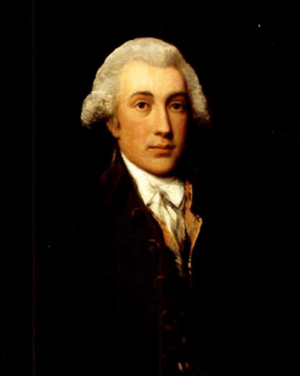Sir William Erskine, 2nd Baronet facts for kids
Quick facts for kids
Sir
William Erskine
|
|
|---|---|

Erskine as a major, by George Romney
|
|
| Member of Parliament for Fife |
|
| In office 1796–1806 |
|
| Personal details | |
| Born | 30 March 1770 |
| Died | 15 May 1813 Lisbon |
| Cause of death | ... by jumping |
| Relations | Sir William Erskine, 1st Baronet (father) |
| Military service | |
| Allegiance | United Kingdom |
| Branch/service | British Army |
| Years of service | 1785–1813 |
| Rank | Major-General |
| Commands | 15th Light Dragoons Brigade, Corunna Brigade, Walcheren Brigade, 1st Division 5th Division Cavalry Division Light Division 2nd Cavalry Division |
| Battles/wars | |
Major-General Sir William Erskine, 2nd Baronet (born March 30, 1770 – died 1813) was an important officer in the British Army. He also served as a Member of Parliament, helping to make laws for his country. Sir William fought in major battles during the Napoleonic Wars under the famous leader, the Duke of Wellington. Sadly, his military career ended because he struggled with his mental health, and he passed away in 1813.
William was the oldest son of Lieutenant-General Sir William Erskine, 1st Baronet and his second wife, Frances. When his father passed away in 1795, William became the 2nd Baronet. A Baronet is a special title, like a knight, that can be passed down in a family.
Contents
Early Military Career
William Erskine began his army career in 1785. He joined the 23rd Foot regiment. In 1787, he moved to the 5th Dragoons as a lieutenant. By 1791, he became a captain in the 15th King's Light Dragoons. This was the same unit his father had served in with great success.
First Battles in Flanders
Erskine's first time fighting was in Flanders between 1793 and 1795. This was during the French Revolutionary Wars. He worked as an aide-de-camp, which is like a personal assistant, to his father. In 1794, he was promoted to lieutenant-colonel. He fought in the Battle of Villers-en-Cauchies. In this battle, a small group of British and Austrian cavalry defeated a much larger French force.
Political Role and Promotion
After his father's death in 1795, Erskine became a Baronet. He also represented Fife in the British Parliament. He served as a Member of Parliament in 1796 and again from 1802 to 1805. Even though he had poor eyesight, Erskine was promoted to major general in 1808. When the Duke of Wellington heard Erskine was coming to Portugal, he was a bit worried. However, the army leaders said that even though Erskine could be a "little wild" sometimes, he was very clever during his clear moments.
Peninsular War Campaigns
During the 1811 military campaign in Portugal, Erskine took command of the famous Light Division. This happened when its usual leader, Robert Craufurd, was away. Erskine quickly became known for taking risks. Wellington, his commander, wrote that it was "impossible to trust to his judgment in any critical case."
Chasing the French Army
As Wellington's army chased Marshal Andre Massena's French army, there were several small but fierce battles. These fights happened at places like Pombal, Redinha, Casal Novo, and Foz do Arouce. Erskine's Light Division often fought against Marshal Michel Ney's rearguard, which was the part of the French army that protected the main force from behind.
Casal Novo Incident
At Casal Novo on March 14, 1811, Erskine made a mistake. He moved his soldiers forward in a thick fog without sending out scouts to check ahead. When the fog suddenly cleared, his leading troops found themselves directly facing French soldiers with cannons. This mistake caused 155 of Erskine's men to be killed or wounded. The French, however, lost only 55 men.
Battle of Sabugal
At the Battle of Sabugal, fog and Erskine's actions helped a French army group escape. Wellington had planned for Erskine, with the Light Division and some cavalry, to attack the French from behind. Meanwhile, four other divisions would attack from the front. However, Erskine, who had very poor eyesight, gave confusing orders. He then got lost in the fog with the cavalry. This allowed the French to get away from Wellington's trap.
Siege of Almeida and Final Days
During the Battle of Fuentes de Onoro, Erskine's 5th Division helped cover the Siege of Almeida. After the French relief army was turned back, the French soldiers inside the fortress managed to sneak out at night. They marched right through the British forces that were supposed to be blocking them. Wellington was very upset about this escape.
Because of his struggles with mental health, Sir William Erskine was eventually relieved of his command. He passed away tragically in Lisbon in 1813.

